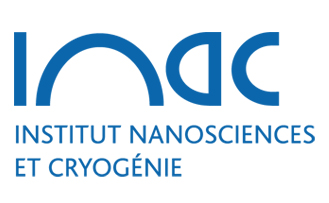Nonredox thiolation in tRNA occurring via sulfur activation by a [4Fe-4S] cluster
Résumé
Sulfur is present in several nucleosides within tRNAs. In particular, thiolation of the universally conserved methyl-uridine at position 54 stabilizes tRNAs from thermophilic bacteria and hyperthermo-philic archaea and is required for growth at high temperature. The simple nonredox substitution of the C2-uridine carbonyl oxygen by sulfur is catalyzed by tRNA thiouridine synthetases called TtuA. Spectroscopic, enzymatic, and structural studies indicate that TtuA carries a catalytically essential [4Fe-4S] cluster and requires ATP for activity. A series of crystal structures shows that (i) the cluster is ligated by only three cysteines that are fully conserved, allowing the fourth unique iron to bind a small ligand, such as exogenous sulfide, and (ii) the ATP binding site, localized thanks to a protein-bound AMP molecule, a reaction product, is adjacent to the cluster. A mechanism for tRNA sulfuration is suggested, in which the unique iron of the catalytic cluster serves to bind exogenous sul-fide, thus acting as a sulfur carrier. tRNA modification | thiolation | [Fe-S] cluster | thiouridine synthetase | U54-tRNA T he cellular translation machinery contains essential components such as tRNAs. To achieve their function, they feature a great variety of well-conserved posttranscriptional chemical modifications. Sulfur is present in several of these modified nucleosides: thiouridine and derivatives (s 4 U8, s 2 U34, and m 5 s 2 U54), 2-thioadenosine derivatives (ms 2 i 6 A37 and ms 2 t 6 A37), and 2-thiocytidine (s 2 C32). However, mechanisms of sulfur insertion into tRNAs are largely unknown, and the enzymes responsible for these reactions are incompletely characterized. Whereas redox conversion of a C-H to a C-S bond (synthesis of ms 2 i 6 A37 and ms 2 t 6 A37) depends on redox enzymes from the RadicalS -adenosyl-L-methionine iron-sulfur enzyme family, simple nonredox conversion of C = O to C = S group (synthesis of s 2 U34 and s 4 U8) is not expected to require such redox clusters. Intriguingly, we recently discovered that the ATP-dependent formation of s 2 C32 in some tRNAs is catalyzed by an iron-sulfur enzyme, TtcA (1). However, the role of its cluster has not been defined. In the same superfamily, TtuA enzymes catalyze the C2-thiolation of uridine 54 in the T loop of thermophilic tRNAs (Fig. 1A), allowing stabilization of tRNAs at high temperature in thermophilic microorganisms. Sequences analysis shows that they share conserved cysteines and ATP binding motif (Fig. S1). Here, we report a detailed biochemical and structural characterization of TtuA that shows the presence of a [4Fe-4S] cluster essential for activity. The crystal structures of Pyrococcus horikoshii TtuA (PhTtuA) show that the cluster, chelated by only three cysteines, is adjacent to the ATP binding site. The presence of electron density near the fourth iron, nonbonded to the protein, indicates that the cluster can bind an exogenous substrate. We propose that thiolation occurs via sulfur binding to the cluster and transfer to the tRNA substrate. The fact that the catalytic [4Fe-4S] cluster serves as a sulfur carrier during a nonredox thiolation reaction illustrates an unknown function in iron-sulfur enzymology. Results m 5 s 2 U but Not s 2 C Is Present in tRNAs from Thermotoga maritima. In the Thermotoga maritima genome, only one homolog of the ttuA gene was detected (2). It was earlier suggested that TtuA could perform thiolation of both C32 and m 5 U54 in this organism (2), because both s 2 C and m 5 s 2 U were detected in bulk tRNAs (3). However, our results show that, although 10.7 m 5 s 2 U modifications per 1,000 uridines were detected, both m 5 U and s 2 C were under the threshold of detection (below one modification per million normal nucleosides) (Fig. S2). T. maritima TtuA Binds an [Fe-S] Cluster. Recombinant T. maritima TtuA (TmTtuA) was purified as an apoprotein, apo-TmTtuA (Fig. 2A and Fig. S3A), then anaerobically treated with ferrous iron and L-cysteine in the presence of a cysteine desulfurase, and finally, purified (Fig. S3B) in the form of a homogeneous dimeric brownish protein, named holo-TmTtuA. Metal analysis (1.6 ± 0.1 Zn, 3.1 ± 0.2 Fe, and 2.6 ± 0.3 S per monomer) and UV-visible as well as EPR spectroscopy (Fig. 2) show that one TmTtuA monomer binds Significance Posttranscriptional modifications of tRNA are essential for trans-lational fidelity. More specifically, mechanisms of selective sul-furation of tRNAs are still largely unknown, and the enzymes responsible for these reactions are incompletely investigated. Therefore, characterizing such systems at the molecular level is greatly valuable to our understanding of a whole class of tRNA modification reactions. We study TtuA, a representative member of a tRNA modification enzyme superfamily, and show that it intriguingly catalyzes a nonredox sulfur insertion within tRNA using a catalytically essential [4Fe-4S] cluster. This report opens perspectives regarding functions of iron-sulfur proteins in biology as well as chemical reactions catalyzed by iron-sulfur clusters.
Origine : Fichiers éditeurs autorisés sur une archive ouverte
Loading...

